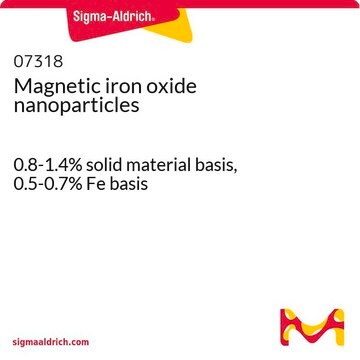TEM used to check particle size. Light Scattering or similar methods are not utilized.
Kluczowe dokumenty
700320
Iron oxide(II,III), magnetic nanoparticles solution
5 nm avg. part. size, 5 mg/mL in toluene
Synonim(y):
Magnetic iron oxide nanocrystals, Magnetite, Superparamagnetic iron oxide nanoparticles
Wybierz wielkość
1110,00 zł
Wybierz wielkość
About This Item
1110,00 zł
Polecane produkty
Formularz
nanoparticles
solution
Poziom jakości
stężenie
5 mg/mL in toluene
namagnesowanie
≥30 emu/g (at ambient temperature under 4500 Oe)
śr. rozm. cząst.
5 nm
wielkość cząstki
5 nm±1 nm (TEM; conforms)
gęstość
0.865 g/mL at 25 °C
ciąg SMILES
O=[Fe].O=[Fe]O[Fe]=O
InChI
1S/3Fe.4O
Klucz InChI
SZVJSHCCFOBDDC-UHFFFAOYSA-N
Szukasz podobnych produktów? Odwiedź Przewodnik dotyczący porównywania produktów
Powiązane kategorie
Opis ogólny
Hasło ostrzegawcze
Danger
Zwroty wskazujące rodzaj zagrożenia
Zwroty wskazujące środki ostrożności
Klasyfikacja zagrożeń
Aquatic Chronic 3 - Asp. Tox. 1 - Flam. Liq. 2 - Repr. 2 - Skin Irrit. 2 - STOT RE 2 - STOT SE 3
Organy docelowe
Central nervous system
Kod klasy składowania
3 - Flammable liquids
Klasa zagrożenia wodnego (WGK)
WGK 3
Temperatura zapłonu (°F)
39.9 °F
Temperatura zapłonu (°C)
4.4 °C
Środki ochrony indywidualnej
Eyeshields, Faceshields, Gloves, type ABEK (EN14387) respirator filter
Wykazy regulacyjne
Wykazy regulacyjne dotyczą głównie produktów chemicznych. Można w nich podawać ograniczoną liczbę informacji na temat produktów niechemicznych. Brak wpisu oznacza, że żaden ze składników nie znajduje się w wykazie. Użytkownik odpowiada za zagwarantowanie bezpiecznego i zgodnego z prawem stosowania produktu.
EU REACH Annex XVII (Restriction List)
Wybierz jedną z najnowszych wersji:
Masz już ten produkt?
Dokumenty związane z niedawno zakupionymi produktami zostały zamieszczone w Bibliotece dokumentów.
Klienci oglądali również te produkty
Produkty
Graphene is a unique two-dimensional (2D) structure of monolayer carbon atoms packed into a dense honeycomb crystal that has attracted great interest due to its diverse and fascinating properties.
Professor Hui Mao explores the use of superparamagnetic iron oxide nanoparticles (INOPs) that offer an alternate contrast-enhancing mechanism.
Prof. Yadong Yin discusses various synthesis methods of magnetite nanocrystals and their applications in different fields.
Prof. Yadong Yin omawia różne metody syntezy nanokryształów magnetytu i ich zastosowania w różnych dziedzinach.
-
What method is used to determine the size of the particles in Product 700320, Iron oxide, magnetic?
1 answer-
Helpful?
-
-
What is the coating thickness of oleic acid on product number 700312, 700320, and 700304, Iron oxide(II,III), magnetic nanoparticles solution?
1 answer-
The suppliers of the magnetic iron oxide nanoparticles in toluene have indicated that the particles are essentially coated with a monolayer of oleic acid. Since the oleic acid is a long chain hydrocarbon there can exist some folding and irregular structure on the surface. The suppliers estimate that one should add 1-2 nm to the particle size due to the presence of the oleic acid coating. From this, 1.5 nm is the closest approximation of coating thickness as provided by our suppliers.
Helpful?
-
-
How is the magnetization of Product 700320, Iron oxide, magnetic, determined?
1 answer-
Per the supplier, the magnetization is determined by using a Magnetic Susceptibility Balance.
Helpful?
-
-
How should a sample of the Iron oxide(II,III), magnetic nanoparticles solution in toluene be prepared for analysis by transmission electron microscopy (TEM)?
1 answer-
The particle size is determined by TEM.If the solution as provided is not diluted, a superlattice of multilayer nanocrystals will form on the grid, appearing to be an aggregate. The solution can be diluted with the same solvent that it was shipped in (toluene). A solution diluted to 0.1-0.5 mg/mL should be concentrated enough to get a nice picture. One drop per grid should be sufficient. (Since the solution is provided at a concentration of 5 mg/mL, this would be a 10- to 50-fold dilution.)After applying the sample to the grid, a drying time of a minimum of 10-15 minutes is recommended.After performing several successful dilutions and getting good results, the analyst will get a feel for the correct dilution just by judging the color and darkness of the diluted sample. If you see lone isolated dots in the TEM, then your sample is too dilute. If you cannot distinguish separate particles, it is too concentrated. Good record keeping will help to zero in on the best dilution factor for the type of picture that you want.
Helpful?
-
-
What is the Department of Transportation shipping information for this product?
1 answer-
Transportation information can be found in Section 14 of the product's (M)SDS.To access the shipping information for this material, use the link on the product detail page for the product.
Helpful?
-
-
What is the purpose of the oleic acid in Product 700320, Iron oxide, magnetic?
1 answer-
Per the manufacturer, the oleic acid allows the iron oxide nanoparticles to be soluble in the solvent (i.e. toluene).
Helpful?
-
Active Filters
Nasz zespół naukowców ma doświadczenie we wszystkich obszarach badań, w tym w naukach przyrodniczych, materiałoznawstwie, syntezie chemicznej, chromatografii, analityce i wielu innych dziedzinach.
Skontaktuj się z zespołem ds. pomocy technicznej



